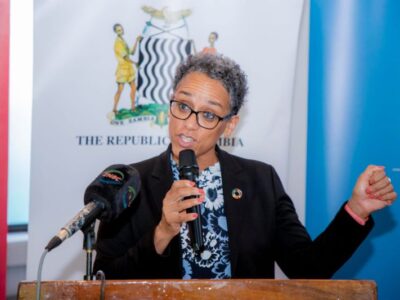The financial performance and condition of Zambia’s banking sector was satisfactory at the end of the third quarter of 2022, as non-performing loans remain below the prudential benchmark of 10 percent.
This is mainly attributed to strong capital adequacy position and earnings performance, according to the Bank of Zambia (BoZ) Deputy Governor-Operations Francis Chipimo.
Chipimo said this recently at the 2022 economic performance and 2023 outlook town hall meeting in Lusaka.
“The banking sector remained adequately capitalised with a capital adequacy ratio of over 20.0 percent, since the third quarter of 2021, relative to the minimum prudential requirements of five percent and 10.0 percent for primary and total regulatory capital ratios, respectively,” he said.
Chipimo also said asset quality remained satisfactory as the proportion of non-performing loans to gross loans (NPL ratio) was consistently below the prudential benchmark of 10.0 percent.
Read more: Zambia’s financial institutions facing weak governance structures — IMF report
He explained that the ratio of NPLs in the banking sector to gross loans stood at 5.8 percent at end November 2022 below the prudential benchmark of 10.0 percent.
He pointed out that the overall financial performance and condition of the NBFIs sector was also rated satisfactory as at November 2022.
“Regulatory capital, earnings performance, liquidity management, and sensitivity to market risk were all satisfactory, while the asset quality was deemed fair.
“The ratio of NPLs in the Non-Bank Financial Intermediaries (NBFIs) sector to gross loans stood at 14.1 percent at end November 2022 and remained above the prudential benchmark of 10.0 percent,” Chipimo said.
Meanwhile, Chipimo said treasury bill and Government bond yield rates broadly trended downwards from the second half of 2021.
He explained that this was mainly due to the pick-up in demand (high subscription rates) in the primary market.
Chipimo said this was backed by improved investor sentiment associated with the International Monetary Fund (IMF) Special Drawing Rights (SDR) allocation in August 2021 and improved budget execution and overall fiscal discipline.
“However, from April 2022, yield rates on Government securities have recently ticked up on account of subdued demand largely due to tight liquidity conditions and reduced non-resident investor appetite.
“Despite the decline in yield rates and inflation, commercial banks’ average lending rate has remained relatively high at around 25.0 percent,” Chipimo said.












Comments